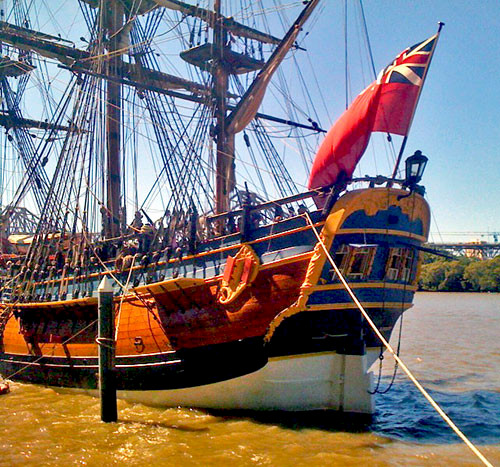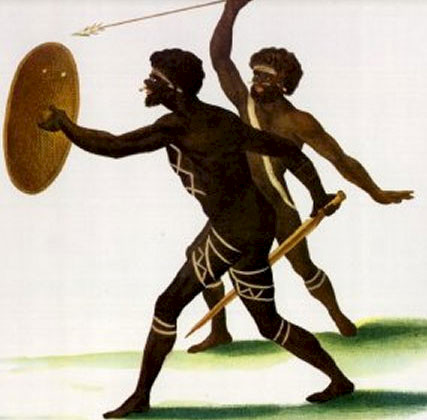HMB Endeavour sets sail
Bill Dennison ·Dr. Nigel Erskine, Curator of Exploration at the Australian National Maritime Museum in Sydney, talked about the HMB Endeavour voyage. He explained that the Endeavour was correctly called HM Barque (or Bark), which was what the British Royal Navy designated the Endeavour that Cook sailed in, even though it was ship-rigged (three or more masts, with square sails on each mast). The HMB Endeavour also distinguished it from another ship in the Royal Navy named the HMS Endeavour.
The original HMB Endeavour was a collier, a versatile ship designed to carry bulk cargo, especially coal, which was what young James Cook sailed in his merchant marine career that preceded his naval career. There were several advantages of sailing a collier, in that it could sit relatively upright in the mud at low tide, did not require a large crew and was incredibly strong.
The ship that had 'discovered' Tahiti in 1767 was the HMS Dolphin, which was a faster and larger ship, but required 160 crew. Based on the reports from the HMS Dolphin, Tahiti was selected as one of many locations around the globe to observe the transit of Venus due to the friendly people, good anchorage, and availability of food and water. Tahiti has high mountains, easily visible from sea as well.
The HMB Endeavour required less than 100 crew and Nigel Erskine thought that the exact crew size was uncertain. Joseph Banks had quite an entourage with him, including Dr. Solander, two artists, two man-servants, two 'black servants' and even 2 dogs. The HMB Endeavour was a very functional and utilitarian vessel, and on subsequent voyages Cooks' ships had more ornate features to make the ships more impressive. And, of course, he always sailed with two ships to avoid the potential tragedy of sinking.

One of the interesting cultural observations that Cook made in the voyage of the HMB Endeavour was the relationship between Tahitian Polynesians and the Maori Polynesians on New Zealand. The Endeavour brought a Tahitian with them to New Zealand and he was able to be understood by Maoris that they encountered. This not only helped with their diplomacy, but Cook correctly recognized the interconnected cultures of Polynesia.
Nigel Erskine showed a drawing by Sydney Parkinson of the initial contact that Cook made with Australian aborigines at Botany Bay, with an indigenous Australian holding a shield that had two small eye holes. He explained he had seen a wooden shield collected by Cook that was in the British Museum, the only indigenous Australian artefact that has been provenanced to Cook's voyage.

Nigel also showed some underwater photographs that he had taken diving on the Endeavour Reef where Cook went aground (the dangers of sailing in uncharted waters by moonlight). The archeology team found that there still were metal objects jettisoned by Cook in an attempt to refloat the Endeavour. He also has dived in Narragansett Bay, where the Endeavour had been intentionally scuttled by the British Navy in 1778 as part of the Revolutionary War.
Captain Ross Mattson, the Master of the replica HMB Endeavour, also spoke about the circumnavigation of Australia that they were undertaking. He has 16 professional crew and they take 36 volunteer crew on each leg of the voyage using a three watch system. The volunteer crew climb the rigging, set and strike sails and sleep in hammocks. They also take up to 4 supernumeraries who are passengers.
Ross calculates an average speed over ground of 2.5 knots in voyage planning, which sounds incredibly slow. But considering that the HMB Endeavour can only sail 80o to windward and that they only used the 'iron staysail' (motor) sparingly, they were often at the mercy of the winds.

Captain Mattson showed some video clips of the Endeavour heeled over in high winds and photos of waterspouts that they encountered on their recent trip up from Sydney Harbour. He said they actually went as fast as 12 knots, which is incredible, considering the bluff bow of the Endeavour. I asked how faithful they would be to the original Cook voyage track and he said that it was up to the wind and tides as to the actual voyage track that they would take.
The Endeavour's next port call is Gladstone and will continue around Australia in a counter-clockwise direction, with a cruise schedule to avoid cyclones and nasty storms of the Southern Ocean. At each port call, they will offer tours of the HMB Endeavour, giving Australians an opportunity to view this beautiful ship that is so historically significant for Australia.
This is the last of three posts about the voyage of the Endeavour
The other two posts are:
1. Scientific discovery aboard the HMS Endeavour
2. The HMS Endeavour ‘discovers’ the Great Barrier Reef
About the author
Bill Dennison

Dr. Bill Dennison is a Professor of Marine Science and Vice President for Science Application at the University of Maryland Center for Environmental Science.

